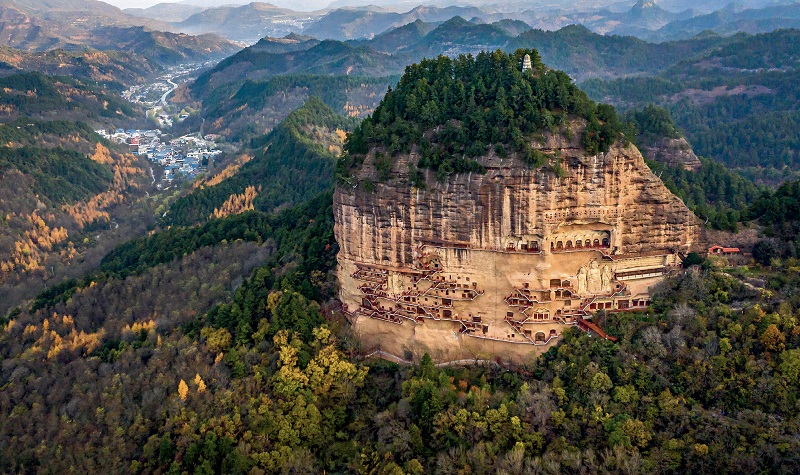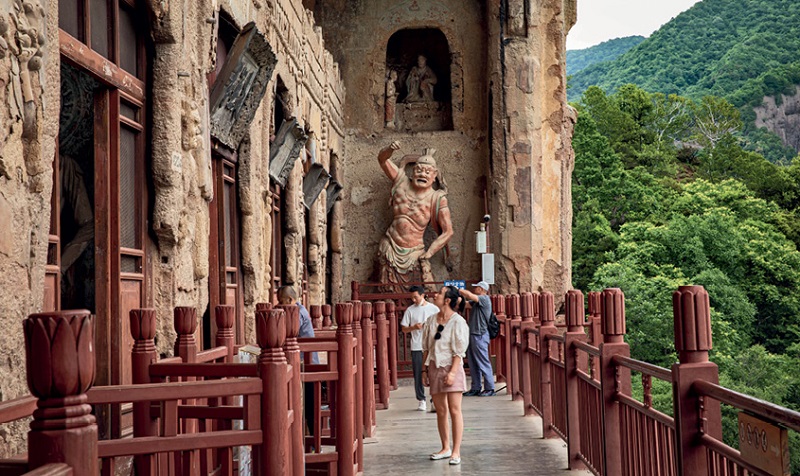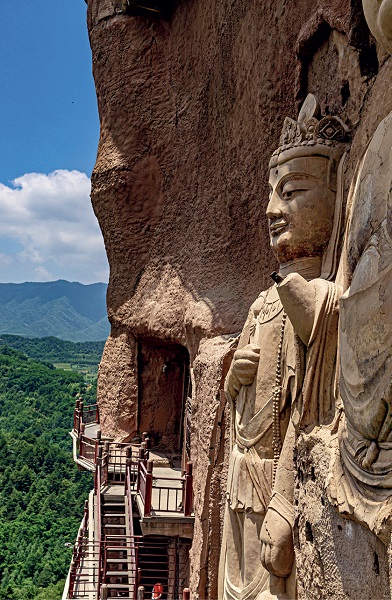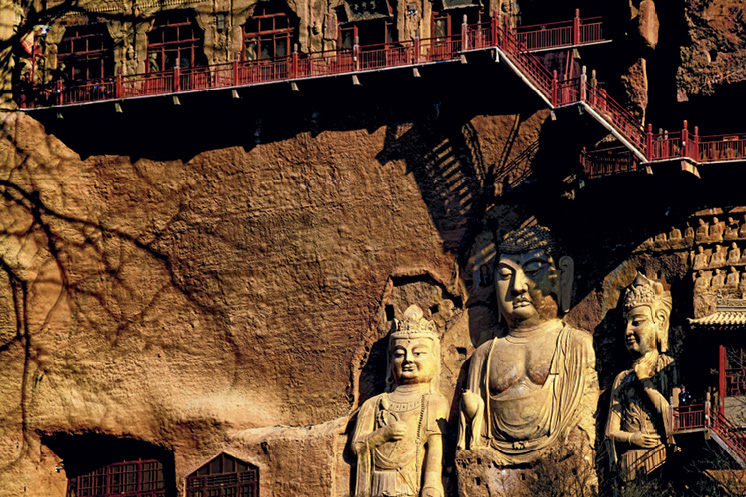
A stunning display of colors of the Maiji Mountain during autumn.
Maiji Mountain Scenic Area is located in Tianshui City of northwest China’s Gansu Province, and consists of more than 180 attractions located in five scenic sub-sections: Maiji Mountain Grottoes, Immortal Cliff, Stone Gate, Quxi Stream, and Jieting Hot Spring. The Maiji Mountain stands at an elevation of 1,400 to 1,800 meters above sea level — with the highest peak rising to 2,200 meters. It also functions as the watershed of the Yellow River and the Yangtze River basins. Maiji boasts a plethora of plants and animal species, geological features, and well-preserved grotto culture. For these exceptional features, it has been designated as a national 5A tourist attraction. It is also a national forest park, a national geological park, and a national natural and cultural heritage site. In 2014, Maiji Mountain Grottoes, as part of the Silk Road: the Routes Network of Chang’an-Tianshan Corridor, was included in the UNESCO World Heritage List.

The Upper Seven Buddhas Pavilion is a must-visit among all the grottoes at Maiji.
Maiji Mountain Grottoes
The literal meaning of the word Maiji is “wheat stacks.” Seen from a distance, the majestic Maiji resembles a gigantic stack of wheat. The well-known Maiji Mountain Grottoes were built atop steep peaks, with the highest point reaching nearly 100 meters above sea level. The caves, densely arranged like beehives, are connected by overhead wooden walkways erected on the cliff side, making walking on them an incredibly unique and terrifying experience.
The construction of those grottoes started in the early fifth century. Today, 194 caves remain, hosting more than 7,800 pieces of clay sculptures and stone carvings, and over 1,000 square meters of murals. The art pieces exhibit an array of subjects and exquisite artistic skills.
The grottoes in Maiji are famous for clay and stone sculptures which are also the major form of art found there. As the only grottoes that comprehensively showcase the evolution of China’s clay sculpture history from the fifth century to the 18th century, Maiji is recognized as one of China’s four greatest grottoes.
Before reaching the foot of the mountain, visitors can see three Buddha statues from the Sui Dynasty (581-618) greeting them with a gentle gaze from afar. Climbing up the stairs, visitors may experience an adrenaline rush while crossing the frightening wooden steps attached to the cliffs. In Cave No. 78, there three Buddhas statues sitting atop high altars on three sides of the cave. According to historians, this cave is one of the earliest grottoes carved in Maiji Mountain, dating back more than 1,500 years to the Later Qin period (384-417).
After faring through the beehive-like caves, visitors will be rewarded by exquisite sculptures. Buddha statues of various sizes from different dynasties, in different appearances, and some even with foreign looking features are slotted into different niches along the structure.
The Upper Seven Buddhas Pavilion, also known as the “Flower Scattering House,” is the largest palace-style cave in China. With a height of 16 meters, width of 31 meters, and depth of 8 meters, it is the largest such wooden palace structure built on cliffs in ancient China. The exquisite and magnificent carving makes it an invaluable source for studying the evolution of China’s ancient architectural practices.
Standing on the narrow passage looking down about 70 meters to the ground below, visitors can experience the sheer steepness and danger of the elevation. The experience serves as a realization of the immensity of the hardship and challenges overcome by ancient monks and believers who made the perilous journey to these places. The grottoes are magnificent and timeless, and even after the passage of millennia, people are in awe of the spectacle they present.
Tianshui, where Maiji Mountain is located, sits at the intersection of the southern and central routes of the Silk Road. It was an ancient town on the Silk Road that connected civilizations of the East and the West. Along this road, silk merchants as well as Buddhist monks traveled between Chang’an and regions in the West. Accompanied by ringing bells on camels, eminent Buddhist monks, such as Faxian, Kumarajiva, and Xuanzang, traveled west or east along this route for religious and cultural exchanges.
The large amount of physical relics and artifacts pertaining to religion, art, and architecture that has been preserved in the Maiji Mountain Grottoes provides a wealth of information and historical knowledge for future generations to study Buddhist culture in China.

A gigantic Buddha statue on the East Cliff calmly gazes out over the world.
Immortal Cliff
Immortal Cliff is a famous attraction of Maiji Mountain. It was named after the legend that immortals resided here seeking enlightenment. This attraction consists of three cliffs, five peaks, six temples, and a lake. Preserved on the cliffs and peaks are 27 temples, 54 houses, 197 statues from different dynasties, and 82 square meters of murals. The existing temples here were built and repaired in the Tang, Song, Ming, and Qing dynasties. Some of the clay sculptures are works of the late Northern Wei Dynasty (386-534), and the existing buildings were mainly built in the Ming (1368-1644) and Qing (1644-1911) dynasties.
The historical buildings are concentrated on three cliffs: the West Cliff, East Cliff, and South Cliff. Under the sheer drop of the West Cliff stand many temples. For a long time, it has been a sacred place where Buddhism, Taoism, and Confucianism coexist.
The building on the East Cliff is called Lotus Temple, and in the long and narrow cave, there lies several structures, such as Arhat Hall, Avalokitesvara Hall, and Zen Courtyard.
A legend has been circulating around the South Cliff. In ancient times, a pavilion called lantern-lighting pavilion was built at the foot of the South Cliff. In late summer and autumn nights, the natural phosphorescence and the oil lamp and candlelight in the pavilion floated and flickered, presenting a picture as if immortals were carrying lamps going back and forth.
Between the East and West Cliffs, there is a palace called Grinding Needle Palace, which is said to be the place where the young Tang poet Li Bai was taught about perseverance by an old lady who showed him how an iron rod can be ground into a needle.
After visiting the temple, visitors can enjoy the Immortal Lake under the cliffs, where the turquoise water reflects the imposing cliffs.

The Maiji Mountain Grottoes serve as a meeting point for cultural exchange and integration.
Harmony of Mountain and Water
Another must-visit spot in Maiji Mountain is the Stone Gate Mountain scenic spot. Yuling Peak is a unique lone peak, covered by pines hanging upside down. The famous Juxian Bridge on Stone Gate Mountain is located between the two opposing cliffs of Yuling Peak and Doumu Peak, and is shaped like a lintel, hence the name, Stone Gate. At the Mid-Autumn Festival every year, a full moon hangs between the two peaks, casting gentle shadows through trees, and presenting a uniquely beautiful picture. When it is overcast, the pavilions and palaces on the peak are shrouded with fog as if they are floating in a sea of clouds.
Quxi Stream scenic spot is noted for its idyllic scenery. Quxi’s autumn scenery is favored by many tourists visiting Gansu. It is also among the earliest popular attractions in Gansu to introduce adventurous activities, such as rafting. The water coursing through Quxi Stream remains clear all year round.
Down the stream from Pipa Lake where the rafting journey begins, people can enjoy the stunning view of the long and narrow canyon. Rafters pass through numerous curved coves, or by wide shores, twists and turns, and silent or frothy white waters. People are often dazzled by the scenes created by the juxtaposition of lush mountains, lucid waters, otherworldly river rocks, and blossoming wild flowers.
The low-profile Maiji Mountain is not incredibly high compared with other mountains, but the grottoes chiseled on it render the hill an unparalleled cultural treasure. On the ancient Silk Road, the cultural and natural landscape of Maiji Mountain presents a unique landmark that has fostered cultural interaction and exchanges, and has conveyed the harmonious coexistence of humans and nature.